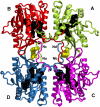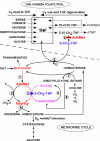Glycine N-methyltransferase and regulation of S-adenosylmethionine levels
- PMID: 19483083
- PMCID: PMC2755656
- DOI: 10.1074/jbc.R109.019273
Glycine N-methyltransferase and regulation of S-adenosylmethionine levels
Abstract
Methylation is a major biological process. It has been shown to be important in formation of compounds such as phosphatidylcholine, creatine, and many others and also participates in epigenetic effects through methylation of histones and DNA. The donor of methyl groups for almost all cellular methylation reactions is S-adenosylmethionine. It seems that the level of S-adenosylmethionine must be regulated in response to developmental stages and metabolic changes, and the enzyme glycine N-methyltransferase has been shown to play a major role in such regulation in mammals. This minireview will focus on the latest discoveries in the elucidation of the mechanism of that regulation.
Figures


References
-
- Cantoni G. L. (1951) J. Biol. Chem. 189,203–216 - PubMed
-
- Mudd S. H. (1963) J. Biol. Chem. 238,2156–2163 - PubMed
-
- Fontecave M., Atta M., Mulliez E. (2004) Trends Biochem. Sci. 29,243–249 - PubMed
-
- Wang S. C., Frey P. A. (2007) Trends Biochem. Sci. 32,101–110 - PubMed
-
- Clarke R., Lewington S., Landray M. (2003) Kidney Int. Suppl. 84,S131–133 - PubMed
Publication types
MeSH terms
Substances
Grants and funding
LinkOut - more resources
Full Text Sources
Other Literature Sources

